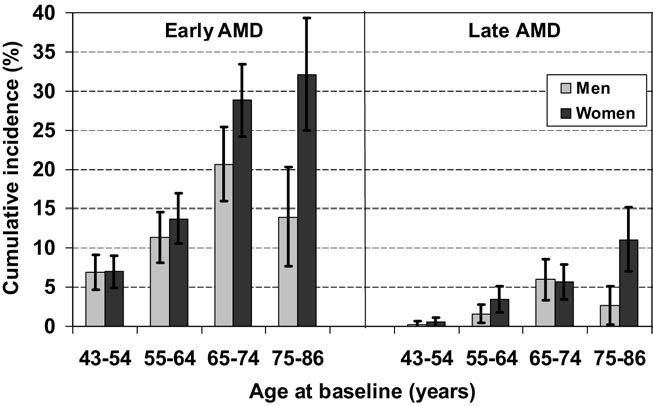Fifteen-year cumulative incidence of age-related macular degeneration: the Beaver Dam Eye Study

Abstract
PURPOSE: To describe the 15-year cumulative incidence of signs of early and late age-related macular degeneration (AMD). DESIGN: Population-based cohort study. PARTICIPANTS: We included 3917 persons, 43 to 86 years of age at the time of a baseline examination in 1988 through 1990 and with information collected in follow-up in 1993 through 1995, and/or 1998 through 2000, and/or 2003 through 2005. METHODS: Grading of stereoscopic fundus photographs using the Wisconsin Age-Related Maculopathy Grading System. MAIN OUTCOME MEASURES: Cumulative incidence of drusen type and size, pigmentary abnormalities, geographic atrophy, and exudative AMD accounting for competing risk of death. RESULTS: The 15-year cumulative incidence was 14.3% for early AMD (the presence of either soft indistinct drusen or the presence of pigmentary abnormalities together with any type of drusen) and 3.1% for late AMD (presence of exudative AMD or geographic atrophy). There was an increased incidence of AMD lesions with age (P<0.05). Individuals > or = 75 years of age at baseline had significantly (P<0.01) higher 15-year incidences of the following characteristics than people 43 to 54 years of age: larger drusen (125 mum in diameter, 24.1% vs 10.6%), soft indistinct drusen (18.7% vs 6.5%), retinal pigmentary abnormalities (20.2% vs 3.7%), exudative macular degeneration (4.4% vs 0.4%), and pure geographic atrophy (3.2% vs 0%). Controlling for age, compared with those with small numbers of only small hard drusen (1-2), those with large numbers of only hard drusen (> or =8) had an increased 15-year age-adjusted incidence of both soft indistinct drusen (16.3% vs 4.7%) and pigmentary abnormalities (10.6% vs 2.7%). Eyes with soft indistinct drusen or pigmentary abnormalities at baseline were more likely to develop late AMD at follow-up than eyes without these lesions (17.8% vs 1.2% and 12.9% vs 1.7%, respectively). CONCLUSIONS: We document the long-term incidence of signs of AMD and a continuum from small hard drusen to late AMD in older persons in the population. The 15-year cumulative incidence of late AMD in people > or = 75 years of age (8%) indicates a public health problem of significant proportions because the United States population this age is expected to increase by 54% between 2005 and 2025.